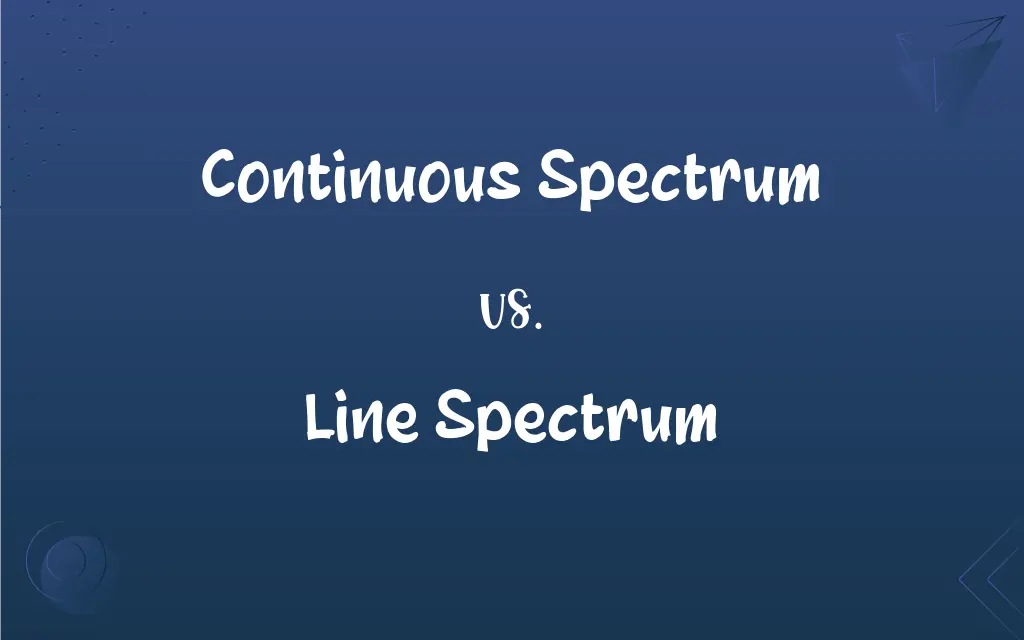Continuous Spectrum vs. Line Spectrum: What's the Difference?
Edited by Aimie Carlson || By Harlon Moss || Updated on October 18, 2023
A continuous spectrum displays all colors without gaps; a line spectrum shows only specific wavelengths as distinct lines.

Key Differences
A continuous spectrum is a spectrum in which all frequencies or wavelengths are represented without any gaps. This is in contrast to a line spectrum, which displays only certain specific frequencies or wavelengths. For instance, when white light passes through a prism, it splits into its constituent colors, producing a continuous spectrum ranging from violet to red. However, when certain gaseous elements are heated, they emit light at specific wavelengths, resulting in a line spectrum with distinct colored lines against a dark background.
In the realm of atomic and molecular physics, both continuous spectrum and line spectrum play crucial roles in understanding the behavior of substances. A continuous spectrum provides a seamless transition of colors or wavelengths, meaning it doesn't exhibit any distinct lines or breaks. On the other hand, a line spectrum is characterized by its distinct lines representing specific wavelengths emitted or absorbed by an element or compound. This characteristic nature of line spectrum makes it invaluable for identifying elements through spectroscopy.
When analyzing light from various sources, one might encounter both continuous spectrum and line spectrum. A typical incandescent light bulb, for instance, produces light that results in a continuous spectrum when analyzed. In contrast, the light emitted from a neon lamp gives a line spectrum. The difference between these two arises from the nature of their sources: a heated solid or liquid generally gives a continuous spectrum, while a heated gas often results in a line spectrum.
The study of both continuous spectrum and line spectrum has paved the way for numerous scientific discoveries. While the continuous spectrum is often associated with broad sources of light and energy, a line spectrum is intrinsically linked with the quantum nature of atoms and molecules. It is through the observation of line spectrum that scientists can pinpoint specific energy levels of atoms, as each line represents a specific energy transition within an atom or molecule.
Fundamentally, both continuous spectrum and line spectrum are representations of light's interaction with matter. The continuous spectrum provides a comprehensive view, showcasing all possible wavelengths without interruption. Conversely, the line spectrum is like a signature, revealing discrete wavelengths that correspond to specific energy transitions in atoms or molecules. Through the study and comparison of these spectrums, scientists gain insights into the properties and behaviors of various materials.
ADVERTISEMENT
Comparison Chart
Definition
Displays all colors without interruptions.
Shows specific wavelengths as distinct lines.
Origin
From broad light sources like stars.
From energy transitions within atoms or molecules.
Representation
Seamless transition of colors.
Individual lines representing specific wavelengths.
Typical Use
General light analysis.
Atomic and molecular analysis.
Information Conveyed
Broad view of the light spectrum.
Detailed insights into atomic or molecular structures and behaviors.
ADVERTISEMENT
Continuous Spectrum and Line Spectrum Definitions
Continuous Spectrum
Continuous spectrum encompasses the entire range of wavelengths.
The rainbow displayed a brilliant continuous spectrum after the rain.
Line Spectrum
Line spectrum consists of discrete lines representing specific wavelengths.
Upon examining the gas, he observed a distinct line spectrum indicating its composition.
Continuous Spectrum
Continuous spectrum lacks gaps or interruptions.
He admired the continuous spectrum for its smooth transition from violet to red.
Line Spectrum
Line spectrum is specific to the substance producing it.
The unique line spectrum of helium helped in its discovery on the sun before it was found on Earth.
Continuous Spectrum
Continuous spectrum shows a seamless array of colors.
The prism produced a beautiful continuous spectrum when white light passed through it.
Line Spectrum
Line spectrum can be emission or absorption based.
The neon sign emitted a bright line spectrum, characteristic of neon gas.
Continuous Spectrum
Continuous spectrum provides a holistic representation of light.
Astronomers often study the continuous spectrum of stars to understand their properties.
Line Spectrum
Line spectrum arises from energy transitions within atoms.
The hydrogen atom produces a unique line spectrum when excited.
Continuous Spectrum
Continuous spectrum results from the dispersion of white light.
Sunlight, when refracted, creates a continuous spectrum showcasing all visible colors.
Line Spectrum
Line spectrum offers insights into atomic and molecular structures.
Chemists use the line spectrum to identify elements in a sample.
FAQs
Can two different elements have the same line spectrum?
No, each element has a unique line spectrum, making it a fingerprint for identification.
How are energy transitions related to the line spectrum?
Energy transitions within atoms or molecules result in the emission or absorption of specific wavelengths, producing a line spectrum.
Does white light produce a continuous or line spectrum?
White light, when dispersed, produces a continuous spectrum.
Can a single element produce a line spectrum?
Yes, individual elements produce specific line spectra when their atoms undergo energy transitions.
Why is a rainbow considered a continuous spectrum?
A rainbow displays all visible colors in a seamless transition, characteristic of a continuous spectrum.
How are spectral lines in a line spectrum formed?
Spectral lines in a line spectrum are formed when atoms or molecules absorb or emit light at specific wavelengths.
Is the line spectrum specific to light?
While commonly associated with light, line spectra can also relate to other electromagnetic radiation forms, like X-rays or radio waves.
Is a continuous spectrum the same as a rainbow?
Yes, a rainbow is a natural example of a continuous spectrum, displaying all visible colors without gaps.
Which spectrum provides information on atomic structure?
The line spectrum provides detailed information on atomic or molecular structures.
What tools can be used to observe a line spectrum?
Spectrometers or spectroscopes are used to observe and analyze line spectra.
Can a single substance produce both continuous and line spectra?
Under different conditions, a substance might produce a continuous spectrum or a line spectrum, but not both simultaneously.
How does a gas discharge tube produce a line spectrum?
When a gas in the discharge tube is excited, its atoms emit light at specific wavelengths, producing a line spectrum.
Can a continuous spectrum be produced in a laboratory?
Yes, using white light and a prism, a continuous spectrum can be produced in a laboratory.
How is the continuous spectrum different from the line spectrum in terms of information?
While a continuous spectrum provides a broad view of light, a line spectrum offers detailed insights into atomic or molecular structure.
Is the line spectrum only associated with atomic transitions?
No, the line spectrum can represent transitions within atoms or molecules.
Is a continuous spectrum limited only to visible light?
No, a continuous spectrum can extend beyond visible light into infrared and ultraviolet regions.
Why is a line spectrum significant in chemistry?
The line spectrum helps identify and analyze the presence of specific elements or molecules in a sample.
Does a continuous spectrum provide detailed information about substance composition?
No, a continuous spectrum gives a broad view of light, while a line spectrum provides detailed insights into substance composition.
What causes the colors in a continuous spectrum?
The dispersion or separation of white light into its constituent wavelengths causes the colors in a continuous spectrum.
How do absorption and emission line spectra differ?
Absorption line spectrum shows missing wavelengths absorbed by a substance, while emission line spectrum displays wavelengths emitted.
About Author
Written by
Harlon MossHarlon is a seasoned quality moderator and accomplished content writer for Difference Wiki. An alumnus of the prestigious University of California, he earned his degree in Computer Science. Leveraging his academic background, Harlon brings a meticulous and informed perspective to his work, ensuring content accuracy and excellence.
Edited by
Aimie CarlsonAimie Carlson, holding a master's degree in English literature, is a fervent English language enthusiast. She lends her writing talents to Difference Wiki, a prominent website that specializes in comparisons, offering readers insightful analyses that both captivate and inform.































































